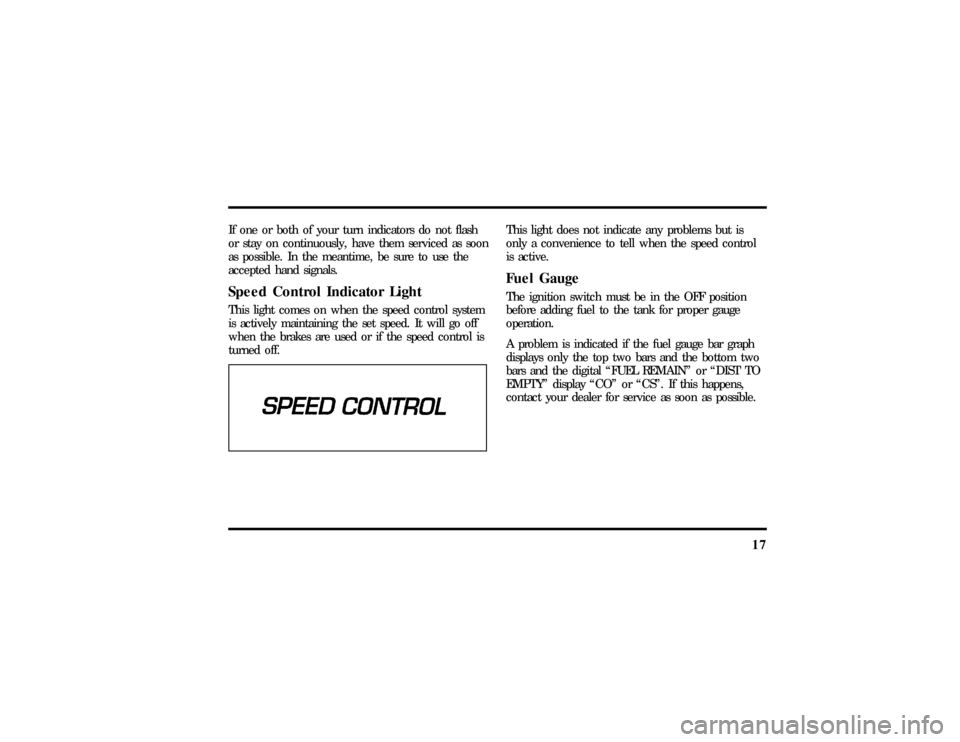brakes LINCOLN TOWN CAR 1997 Owners Manual
[x] Cancel search | Manufacturer: LINCOLN, Model Year: 1997, Model line: TOWN CAR, Model: LINCOLN TOWN CAR 1997Pages: 305, PDF Size: 2.68 MB
Page 11 of 305

5
Breaking Your Vehicle InYour new vehicle goes through an adjustment or
break-in period during the first 1,000 miles
(1,600 km) that you drive it. During the break-in
period, you need to pay careful attention to how
you drive your vehicle.q
Avoid sudden stops.Because your vehicle has
new brake linings, you should take these steps:
Ð Watch traffic carefully so that you can
anticipate when to stop.
Ð Begin braking well in advance.
Ð Apply the brakes gradually.
The break-in period for new brake linings
lasts for 100 miles (160 km) of city driving
or 1,000 miles (1,600 km) of highway
driving.
q
Use only the type of engine oil that Ford
recommends.SeeEngine oil recommendations
in the Index. Do not use special ªbreak-inº oils.
File:02fniit.ex
Update:Mon Jun 17 13:45:23 1996
Page 22 of 305

17
If one or both of your turn indicators do not flash
or stay on continuously, have them serviced as soon
as possible. In the meantime, be sure to use the
accepted hand signals.Speed Control Indicator LightThis light comes on when the speed control system
is actively maintaining the set speed. It will go off
when the brakes are used or if the speed control is
turned off.
This light does not indicate any problems but is
only a convenience to tell when the speed control
is active.Fuel GaugeThe ignition switch must be in the OFF position
before adding fuel to the tank for proper gauge
operation.
A problem is indicated if the fuel gauge bar graph
displays only the top two bars and the bottom two
bars and the digital ªFUEL REMAINº or ªDIST TO
EMPTYº display ªCOº or ªCSº. If this happens,
contact your dealer for service as soon as possible.
File:03fnist.ex
Update:Mon Jun 17 13:46:47 1996
Page 170 of 305

167
DrivingBrakesApplying the BrakesYour vehicle has anti-lock disc brakes on all four
wheels. They adjust automatically as the brake pads
wear down.
When you press down hard on the brake pedal, the
wheels will not lock and slide. The Anti-lock Brake
System (ABS) automatically starts releasing and
reapplying the front brakes independently and the
rear brakes together whenever your wheels start to
lock. When this happens, you will feel the brake
pedal pulsate. This is an indication that the ABS is
working correctly and is normal.
Do not drive with your foot resting on the brake
pedal; you will wear out the linings and increase
your vehicle's stopping distance. Brake rotor damage
may also eventually occur.NOTE:If you are driving down a long or steep hill,
shift to a lower gear and do not apply your brakes
continuously. If you apply your brakes continuously,
they may overheat and become less effective.
Occasional brake squeal during light to moderate
stops does not affect the function of the brake
system and is normal. However, if the squeal
becomes louder or more frequent, have your brakes
inspected by your dealer or a qualified service
technician.
Ford Motor Company has not found any
detrimental effects of popular mobile radio
transmitting equipment installed on vehicles with
the anti-lock brake system, if the equipment is
installed according to the manufacturer's
instructions. However, if mobile radio transmitting
equipment is installed in your vehicle and, if either
the anti-lock brake system cycles or the ANTI-LOCK
File:09fngft.ex
Update:Mon Jun 17 13:52:03 1996
Page 173 of 305

170Traction Assist
TM
(If equipped)
Your vehicle may be equipped with the optional
Traction Assist
TM
system. This system helps prevent
wheel spin in order to improve tire traction and is
an especially useful feature when you drive in hilly
areas or on slippery, icy or snowy roads.
Traction Assist
TM
works automatically by rapidly
applying and releasing the brakes to prevent one or
both of the rear drive wheels from spinning during
acceleration.
During the Traction Assist
TM
function, which most
often occurs during low speed acceleration on
slippery surfaces, a noise may be heard coming from
the engine compartment. This is normal and may
last for a few seconds during the acceleration of the
vehicle.
In general, this system improves your vehicle's
stability and acceleration performance when road
conditions warrant. Traction Assist
TM
is fully
effective up to approximately 25 mph (40 km/h).At 25 mph (40 km/h) the function begins to taper
off until it no longer operates above 34 mph
(55 km/h).
If the Traction Assis;
TM
system is cycled excessively,
the system will shut down to prevent the rear
brakes from overheating. A cooling down period is
required to prevent damage to the brakes. This time
period varies and depends on brake usage during
the cooling down period. Anti-Lock braking is not
affected and will function normally during the cool
down period.
After the cool down period, the Traction Assist
TM
function is restored.%Rear Air Suspension SystemYour vehicle is equipped with an automatic load
leveling rear air suspension system. This system
maintains the rear vehicle height at a constant level
by automatically adding air or releasing air from the
rear air springs to offset changes in vehicle loads.
File:09fngft.ex
Update:Mon Jun 17 13:52:03 1996
Page 263 of 305

262Brakesq
Make sure brakes and parking brake are fully
released.
Tiresq
Maintain recommended air pressures.
Miscellaneousq
Make sure all linkages, cables, levers and clevis
pins under vehicle are covered with grease to
prevent rust.
q
Move vehicles at least 25 feet (8 m) every 15
days to lubricate working parts and prevent
corrosion.
File:12fncst.ex
Update:Thu Jun 20 15:16:56 1996
Page 288 of 305

297
Brake fluid
brake warning light.......... 12
checking and adding......... 221
description............. 221
specifications............ 259
Brakes................ 167
adjustment............. 167
anti-lock.............. 167
applying the brakes.......... 167
brake warning light.......... 11
fluid, checking and adding....... 221
fluid, refill capacities......221, 258
fluid, specifications.......... 259
master cylinder........... 221
new brake linings........... 5
noise................ 167
parking............... 168
servicing.............. 167
when storing your vehicle....... 262Break-in period.............. 5
Brights (high beams).......... 13
Bulbs, replacing............ 248
halogen............... 249
headlamps.............. 249
C
Canada, customer assistance....... 270
Canada, warranty information....... 3
Canadian Motor Vehicle Arbitration Plan
(CAMVAP).............. 271
Capacities for refilling fluids....... 258
Carbon monoxide in exhaust....... 165
Car seats for children
(see Child safety seats)........ 141
Cassette tape player (see Electronic sound
system)............... 40
Catalytic converter........... 246
Changing a tire............. 192
File:fnixt.ex
Update:Mon Jun 17 13:58:01 1996
Page 297 of 305

306
M
Maintenance schedule and record
(see separate Maintenance Schedule
and Record booklet)........... 3
Maintenance (see Servicing)....... 211
Master cylinder, brakes......... 221
Memory seat (programmable
memory seat)............ 99
Message center
door ajar.............. 31
low washer fluid........... 31
trunk ajar.............. 32
Mileage, calculating fuel economy..... 244
Mirrors
automatic dimming rearview mirror . . . 89
heated............... 101
rearview.............. 89
side view mirrors.......... 100
Moon roof............... 87
Motorcraft parts............ 257
N
National Highway Traffic Safety
Administration............ 263
New vehicle break-in........... 5
O
Octane rating............. 241
Odometer
description............. 21
Oil filter.............220, 257
Oil (see Engine oil)........... 218
Oil viscosity.............. 218
On-board diagnostic (OBD II) system . . . 248
Overseas offices............ 272
P
Panic alarm feature, remote entry system . 112
Parking brake
operation.............. 168
warning light............ 12
Parts (see Motorcraft Parts)....... 257
File:fnixt.ex
Update:Mon Jun 17 13:58:01 1996